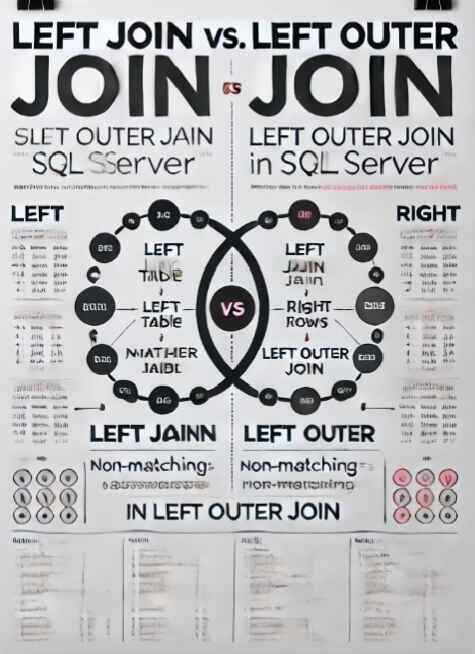When working with SQL Server, you often encounter various types of joins that allow you to retrieve data from multiple tables based on specific conditions. Among these, LEFT JOIN and LEFT OUTER JOIN are commonly used but can sometimes lead to confusion. Are they different? If not, why do we have two terms for what seems to be the same thing
What Is a LEFT JOIN?
A LEFT JOIN is a type of SQL join that retrieves all records from the left table and the matching records from the right table. If there is no match in the right table, the result will contain NULL values for the columns from the right table.
The general syntax for a LEFT JOIN is:
SELECT columns
FROM left_table
LEFT JOIN right_table
ON left_table.column = right_table.column;
Example:
Suppose you have two tables:
Employees:
Departments:
Using a LEFT JOIN to retrieve employee details along with their department names:
SELECT e.EmployeeID, e.Name, d.DepartmentName
FROM Employees e
LEFT JOIN Departments d
ON e.DepartmentID = d.DepartmentID;
Result:
What Is a LEFT OUTER JOIN?
A LEFT OUTER JOIN is the same as a LEFT JOIN. The term “OUTER” explicitly specifies that the join includes non-matching rows from the left table and fills the unmatched columns from the right table with NULL values. However, in practice, the keyword OUTER is optional in SQL Server.
The syntax is as follows:
SELECT columns
FROM left_table
LEFT OUTER JOIN right_table
ON left_table.column = right_table.column;
The output of a LEFT OUTER JOIN is identical to that of a LEFT JOIN.
Key Differences Between LEFT JOIN and LEFT OUTER JOIN
There is no functional difference between a LEFT JOIN and a LEFT OUTER JOIN in SQL Server. Both produce the same result and operate in the same way. The term “OUTER” is optional and often omitted for simplicity.
LEFT JOIN is more commonly used in practice because it is shorter and easier to write.
LEFT OUTER JOIN is more explicit and can be used when you want to emphasize the fact that unmatched rows from the left table will be included.
Why Two Terms?
The reason for having both terms lies in SQL standards. SQL defines three types of outer joins:
1. LEFT OUTER JOIN
2. RIGHT OUTER JOIN
3. FULL OUTER JOIN
SQL Server allows you to omit the word “OUTER” for brevity. Thus:
LEFT OUTER JOIN = LEFT JOIN
RIGHT OUTER JOIN = RIGHT JOIN
FULL OUTER JOIN = FULL JOIN
Best Practices
1. Use LEFT JOIN: Since LEFT JOIN and LEFT OUTER JOIN are equivalent, stick to LEFT JOIN for simplicity and readability.
2. Be Explicit If Necessary: In cases where clarity is essential, such as documentation or when teaching SQL, use LEFT OUTER JOIN to explicitly convey its meaning.
3. Test Results: Always verify your query results, especially when working with complex joins involving multiple tables.
Conclusion
In SQL Server, LEFT JOIN and LEFT OUTER JOIN are interchangeable. The choice between them comes down to personal or team preference, with LEFT JOIN being the more concise and commonly used option. Regardless of which term you use, both are powerful tools for retrieving data while preserving unmatched rows from the left table.



